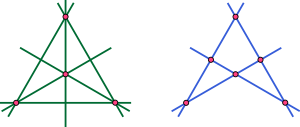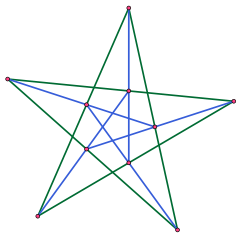- Configuration (geometry)
-
 Configurations (4362) (a complete quadrangle, at left) and (6243) (a complete quadrilateral, at right).
Configurations (4362) (a complete quadrangle, at left) and (6243) (a complete quadrilateral, at right).
In mathematics, specifically projective geometry, a configuration in the plane consists of a finite set of points, and a finite arrangement of lines, such that each point is incident to the same number of lines and each line is incident to the same number of points.
Although certain specific configurations had been studied earlier (for instance by Thomas Kirkman in 1849), the formal study of configurations was first introduced by Theodor Reye in 1876, in the second edition of his book Geometrie der Lage, in the context of a discussion of Desargues' theorem. Ernst Steinitz wrote his dissertation on the subject in 1894, and they were popularized by Hilbert and Cohn-Vossen's 1932 book Anschauliche Geometrie (reprinted in English as Geometry and the Imagination).
Configurations may be studied either as concrete sets of points and lines in a specific geometry, such as the Euclidean or projective planes, or as abstract incidence structures. In the latter case they are closely related to regular hypergraphs and regular bipartite graphs.
Contents
Notation
A configuration in the plane is denoted by (pγ ℓπ), where p is the number of points, ℓ the number of lines, γ the number of lines per point, and π the number of points per line. These numbers necessarily satisfy the equation
as this product is the number of point-line incidences.
The notation (pγ ℓπ) does not determine a projective configuration up to incidence isomorphism. For instance, there exist three different (93 93) configurations: the Pappus configuration and two less notable configurations.
For some configurations, p = ℓ and γ = π, so the notation is often condensed to avoid repetition. For example (93 93) abbreviates to (93).
Examples
Notable projective configurations include the following:
- (11), the simplest possible configuration, consisting of a point incident to a line.
- (32), the triangle. Each of its three sides meets two of its three vertices, and vice versa. More generally any polygon of n sides forms a configuration of type (n2)
- (43 62) and (62 43), the complete quadrangle and complete quadrilateral respectively.
- (73), the Fano plane. This configuration exists as an abstract incidence geometry, but cannot be constructed in the Euclidean plane.
- (83), the Möbius–Kantor configuration. This configuration describes two quadrilaterals that are simultaneously inscribed and circumscribed in each other. It cannot be constructed in Euclidean plane geometry but the equations defining it have nontrivial solutions in complex numbers.
- (93), the Pappus configuration.
- (94 123), the configuration of nine inflection points of a cubic curve in the complex projective plane and the twelve lines determined by pairs of these points. This configuration shares with the Fano plane the property that it contains every line through its points; configurations with this property are known as Sylvester–Gallai configurations due to the Sylvester–Gallai theorem that shows that they cannot be given real-number coordinates (Kelly 1986).
- (103), the Desargues configuration.
- (153), the Cremona–Richmond configuration.
- (124 163), the Reye configuration.
Duality of configurations
The projective dual to a configuration (pγ lπ) is a configuration (lπ pγ). Thus, types of configurations come in dual pairs, except when p = l and the configuration type is self-dual.
The number of (n3) configurations
The number of nonisomorphic configurations of type (n3), starting at n = 7, is given by the sequence
These numbers count configurations as abstract incidence structures, regardless of realizability (Betten, Brinkmann & Pisanski 2000). As Gropp (1997) discusses, nine of the ten (103) configurations, and all of the (113) and (123) configurations, are realizable in the Euclidean plane, but for each n ≥ 16 there is at least one nonrealizable (n3) configuration. Gropp also points out a long-lasting error in this sequence: an 1895 paper attempted to list all (123) configurations, and found 228 of them, but the 229th configuration was not discovered until 1988.
Higher dimensions
The concept of a configuration may be generalized to higher dimensions, for instance to points and lines or planes in space. Notable three-dimensional configurations are the Möbius configuration, consisting of two mutually inscribed tetrahedra, Reye's configuration, consisting of twelve points and twelve planes, with six points per plane and six planes per point, the Gray configuration consisting of a 3×3×3 grid of 27 points and the 27 orthogonal lines through them, and the Schläfli double six, a configuration with 30 points, 12 lines, two lines per point, and five points per line.
A further generalization is obtained in three dimensions by considering incidences of points, lines and planes, or j-spaces (0 ≥ j > 3), where each j-space is incident with Njk k-spaces (j ≠ k). Writing Njj for the number of j-spaces present. a given configuration may be represented by the matrix:
The principle extends generally to n dimensions, where 0 ≥ j > n. Such configurations are related mathematically to regular polytopes (Coxeter 1948).
References
- Berman, Leah W., "Movable (n4) configurations", The Electronic Journal of Combinatorics 13 (1): R104, http://www.combinatorics.org/Volume_13/Abstracts/v13i1r104.html. See also Berman's animations of movable configurations.
- Betten, A; Brinkmann, G.; Pisanski, T. (2000), "Counting symmetric configurations", Discrete Applied Mathematics 99 (1–3): 331–338, doi:10.1016/S0166-218X(99)00143-2.
- Coxeter, H.S.M. (1948), Regular Polytopes, Methuen and Co.
- Gropp, Harald (1997), "Configurations and their realization", Discrete Mathematics 174 (1–3): 137–151, doi:10.1016/S0012-365X(96)00327-5.
- Grünbaum, Branko (2006), "Configurations of points and lines", in Davis, Chandler; Ellers, Erich W., The Coxeter Legacy: Reflections and Projections, American Mathematical Society, pp. 179–225.
- Grünbaum, Branko (2009), Configurations of Points and Lines, Graduate Studies in Mathematics, 103, American Mathematical Society, ISBN 978-0-8218-4308-6.
- Hilbert, David; Cohn-Vossen, Stephan (1952), Geometry and the Imagination (2nd ed.), Chelsea, pp. 94–170, ISBN 0-8284-1087-9.
- Kelly, L. M. (1986), "A resolution of the Sylvester–Gallai problem of J. P. Serre", Discrete and Computational Geometry 1 (1): 101–104, doi:10.1007/BF02187687.
External links
- Weisstein, Eric W., "Configuration" from MathWorld.
Categories:
Wikimedia Foundation. 2010.




